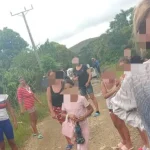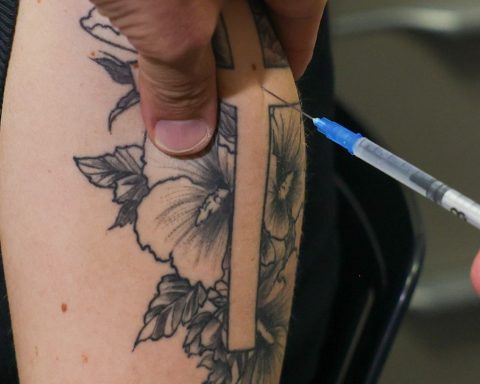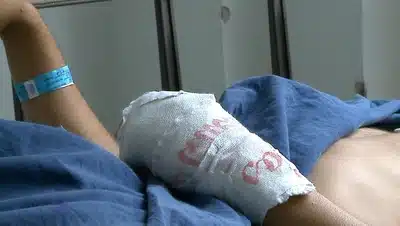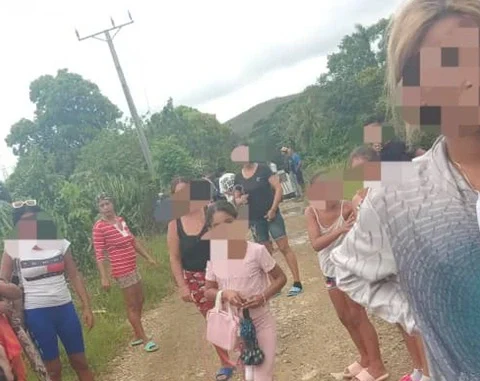the secretary of Human rightsHoracio Pietragalla Corti, deputy Hugo Yasky, union leaders and members of social groups inaugurated on Friday a mural and a plaque in homage to Rodolfo Walsh, journalist, writer and member of the Montoneros organization, killed on March 25, 1977 after holding an unequal confrontation with a task force of the ESMA.
The activity, carried out at the ‘Rodolfo Walsh’ Station of Subway Line E, located on Avenida Entre Ríos and San Juan -where the journalist was killed- was organized by the Buenos Aires Press Union (Sipreba) and the Union Association of Subway and Premetro Workers (AGTSyP).
The mural and the plaque were ready to be inaugurated when Thursday, on the National Day for Memory, for Truth and Justice, a group calling themselves “Young Republicans” vandalized.
The assailants were filmed as they placed graffiti and pamphlets containing the word “murderer” next to Walsh’s name.

The tribute was made within the framework of the Labor Day and Press Workerin commemoration of the sanction of the Statute of the Journalist which is the framework law that regulates the activity in the country, sanctioned by the former president Juan Domingo Peron.
In the act, Rodolfo Walsh’s granddaughterFiorella Metetieri, affirmed that “it is important to be grateful that there are people who keep alive and honor the memory of the people who fought for a fairer countrywho denounced human rights violations”.
Meanwhile, Pietragalla Corti, after reaffirming that the Human Rights Secretariat was “very happy” to be part of the tribute, and considered that the struggle of the 30 thousand disappeared “It was not free” because “they made their own life available to the other, which is the greatest heritage that a human being has.”
Along these lines, Pietragalla Corti stressed that the victims of State terrorism “were not suicidal”, but rather “they bet on the family; they had children and they liked to love, laugh and dance“.
“However, they prioritized the commitment of the political struggle and the resistance to the economic model that installed“the last civic-military dictatorship.

Also, the deputy for the Frente de Todos (FdT) and general secretary of the Central de Trabajadores de la Argentina (CTA), Hugo Yasky, assured Télam that it was “a pride” to participate in this tribute to Walsh “organized by workers”.
“After a massive act like the one we had yesterday (for the Day of Memory, Truth and Justice) in which young people, families and militancy of human rights organizations converged, it is a pride to participate in this tribute from the press and subway workers.
The vandalization that took place on Thursday was repudiated by all the speakers who participated in this tribute to the author of investigative works such as “Operation Massacre” and “Who Killed Rosendo?”
“It is a condemnable act for cowardice and for vindicating genocide. Unfortunately there is a hate speech installed from the office of media power. Vindicating Walsh is vindicating the journalism with social commitment and as an exercise of freedom and independenceYasky told Télam after the act.
The general secretary of the Association of State Workers (ATE) Capital, Daniel Catalano and the general secretary of SiPreBaAgustín Lecchi, among others.
#CABA A mural in memory of companero Rodolfo Walsh was inaugurated in the subway line E station that bears his name, on the 45th anniversary of the kidnapping, disappearance and murder at the hands of a gang from the Argentine Navy.
Read more ➡️ https://t.co/d2xbWkHzUd pic.twitter.com/KDImPcjQ1v
— FATPREN (@PrensaFATPREN) March 25, 2022
“For SiPreBa, honoring Rodolfo Walsh is very important. We saw yesterday how a group of deniers vandalized the station and today the response was forceful. Dozens of workers from a lot of social and political organizations discovered this mural that vindicates the integral figure of Rodolfo, as an intellectual, writer, journalist. but also as revolutionary militant and how press worker who was organizing“Lecchi pointed out to Télam.
On March 25, 1977, when he was trying to spread his “Open Letter to the Military Junta“, a text he had written on the occasion of the first anniversary of the coup that brought Jorge Rafael Videla to government, Walsh fell into a confrontation with a ESMA task force.
The body of the journalist and writer was transferred to the clandestine detention center that the Navy operated in the City of Buenos Aires, and according to testimonies provided by survivors, his remains burned on a pyre mounted on the banks of the River Plate.

The president of the Buenos Aires Cultural Institute reminded the journalist Rodolfo Walsh
The president of the Cultural Institute of the province of Buenos Aires, Florencia Saintout, affirmed on Friday that Rodolfo Walsh’s commitment continues “illuminating collective projects”on the 45th anniversary of the assassination of the writer and journalist at the hands of an ESMA task force.
“TO 45 years after his murder and disappearancewe keep the memory of Rodolfo Walsh alive,” said the Buenos Aires official on her official Twitter social network account, adding: “His revealing work and his commitment to the liberation of the homeland continue to illuminate, more than ever, our collective projects”.
The university professor also shared the institutional publication of the body she presides over in which, together with a video with images of the journalist and his voice in offit was stated that “Walsh’s work is essential to understand the history of a country crossed by popular fights in favor of the democracy and in against the persecutions“.
In addition, it was recalled that members of the civic-military dictatorship not only assassinated him, but also “harmed on his work by looting his house” located in the town of San Vicente.
“Walsh’s living memory is a symbol that culture survives in the action of the people”, indicates the publication and completes: “Walsh claimed his identity as a writer not in opposition to political actions but rather made the ‘violent profession of writing’, his most powerful weapon”.
On March 25, 1977, Walsh was kidnapped by a task force from the then Navy Mechanical School (ESMA), on the corner of San Juan and Entre Ríos in Buenos Aires, after having written and begun to distribute his “Open Letter to the Military Junta“.















